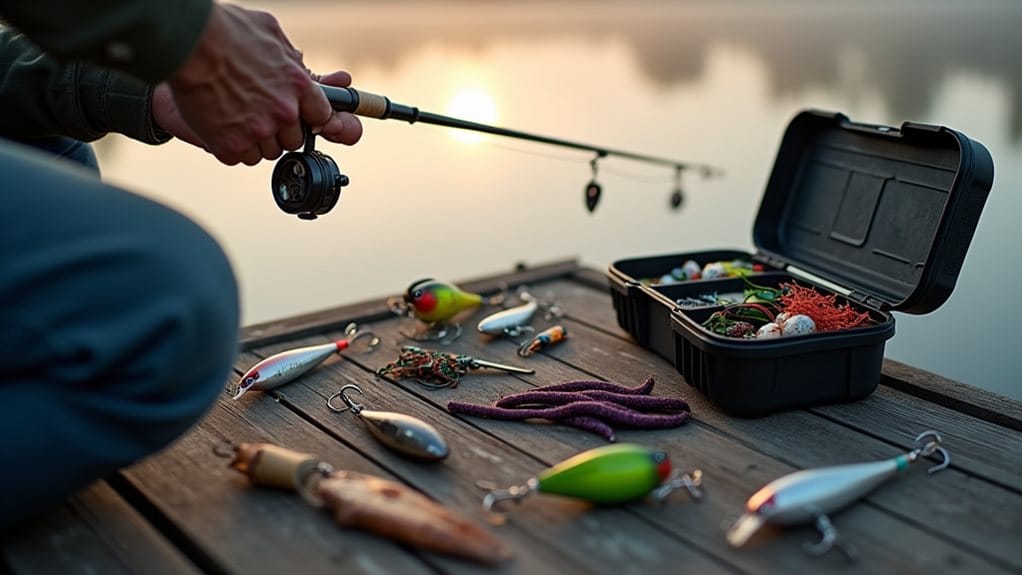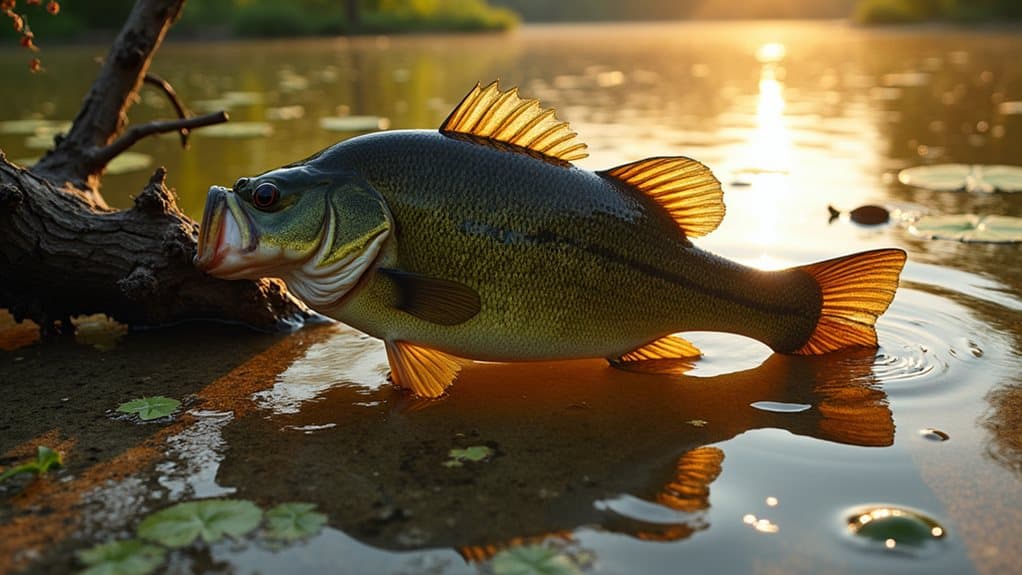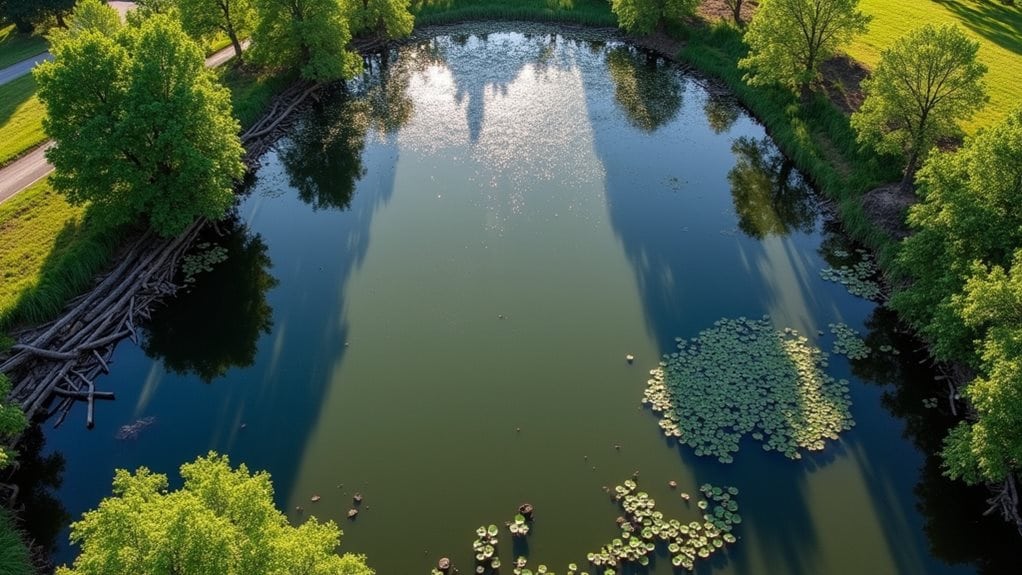To catch big bass in ponds like a pro, focus on key habitat features like fallen logs, aquatic vegetation, and deep-water drop-offs. You’ll need quality gear, including a medium spinning or heavy casting combo with a 5½ to 7-foot graphite rod. Use soft plastics and hollow body frogs, adjusting your lure choice based on weather and season. Stay stealthy by maintaining distance and using natural cover. These fundamentals will help you land trophy bass, but there’s much more to excelling in pond fishing techniques.
TLDR
- Scout pond edges near aquatic vegetation, fallen logs, and deep drop-offs where monster bass seek cover and food.
- Use medium spinning or heavy casting combos with 5½-7 foot graphite rods for optimal control and sensitivity.
- Stay concealed at least 50 feet from water’s edge, using natural cover to avoid spooking bass.
- Watch for surface indicators like ripples, swirls, and “pushes” that reveal active feeding areas.
- Match lure choice to conditions: soft plastics for versatility, hollow frogs for surface, Texas-rigged worms for bottom-dwelling bass.
Essential Gear for Pond Bass Fishing Success

Success in pond bass fishing starts with having the right gear, and you’ll need a carefully selected combination of equipment to maximize your chances of landing those trophy bass.
Your essential setup should include both medium spinning and heavy casting combos, paired with high-quality graphite rods between 5½ to 7 feet long. Leading brands like Dobyns Fury offer exceptional performance for the price point. Additionally, consider exploring Alamo Lake as a prime location for catching larger bass, as it is known for its diverse population including sunfish, crappie, and catfish.
Don’t skimp on reels – invest in models starting around $60 for reliable performance.
Scouting and Identifying Prime Bass Habitats
Finding the perfect bass location starts with understanding where these prized fish naturally congregate in ponds.
Look for edges along the shoreline, especially near aquatic vegetation and fallen logs, where bass ambush their prey. Bass are particularly drawn to areas with Honey Hole habitats that provide ideal cover and spawning grounds. Additionally, be aware that poison ivy can often grow in areas near water, so take precautions when scouting.
You’ll find them lurking around deeper water near dams, along sharp dropoffs, and in areas where creeks feed into the pond, particularly during warmer months.
Top Lure Choices That Land Monster Bass

When targeting monster bass in ponds, selecting the right lure can make the difference between landing a trophy fish and going home empty-handed.
You’ll want to focus on soft plastics for versatility, hollow body frogs for surface action, and Texas-rigged worms for bottom-dwelling lunkers.
Don’t forget to match your lure choice to the season – use faster-moving baits in summer and slower presentations in winter. Additionally, incorporating stress relief through repetitive activity can enhance your fishing experience as you pursue those big bass.
Mastering Stealth Approaches in Small Waters
When you’re fishing small ponds for big bass, your success often depends on how well you can avoid disturbing the water’s surface with excessive movement or noise.
You’ll want to minimize your visibility by staying behind natural cover like trees, bushes, or tall grass while maintaining a distance of at least 50 feet from the water’s edge.
Making your initial casts from these concealed positions lets you test the water without alerting nearby bass to your presence, giving you a better shot at landing that trophy fish. Additionally, using techniques similar to those effective at Lake Kissimmee can enhance your chances of attracting bigger bass.
Avoid Surface Water Disturbance
Mastering stealth tactics while fishing for bass in ponds can make the difference between a successful day and one where the fish remain elusive.
To minimize surface disturbance, you’ll want to move slowly and deliberately along the bank, wearing soft-soled shoes. Make smooth, controlled casts, and keep your distance from target areas.
When possible, use the wind to your advantage by casting into it.
Blend Into Natural Cover
The three essential elements of blending into natural cover while pond fishing are location selection, movement control, and environmental awareness.
Position yourself behind trees or brush to break up your silhouette, and wear muted colors that match your surroundings.
You’ll want to move slowly and deliberately, using available vegetation for concealment while staying mindful of your shadow’s position on the water.
Seasonal Bass Patterns in Pond Environments

Successful bass fishing in ponds requires a thorough understanding of how these predatory fish adapt their behavior throughout the year.
In spring, you’ll find them in shallow waters around vegetation as they prepare to spawn.
During summer, they’ll seek deeper spots or heavy cover.
Fall brings them back to shallows for feeding, while winter drives them to deeper structures where they’re less active.
Advanced Techniques for Pressured Ponds
When fishing highly pressured ponds, you’ll need to adapt your techniques to outsmart bass that have grown wary of common fishing methods.
Try fishing during off-peak hours, like early mornings or on rainy days, and opt for stealthy approaches with subdued clothing and quiet movements.
Use finesse techniques with lighter lines, and experiment with less common lures like small jerkbaits or hand-poured soft plastics.
Weather Impact on Pond Bass Behavior

Understanding weather patterns can dramatically improve your pond bass fishing success, as these fish respond quickly to changing conditions by adjusting their movement and feeding patterns.
During cold fronts, you’ll notice bass becoming more sluggish and retreating to deeper water, requiring you to slow down your presentation and downsize your lures.
You’ll catch more fish by matching your lure selection to the weather conditions, such as using silent, natural-colored baits during high-pressure systems and switching to louder, more aggressive presentations when the barometer starts falling.
Weather-Driven Bass Movement
The ever-changing weather patterns directly influence bass behavior in ponds, making it essential for anglers to adapt their strategies accordingly.
You’ll find bass moving deeper during high-pressure systems, while they’ll become more active when pressure drops.
On windy days, focus on windward shores where baitfish gather, and during sunny conditions, target shaded areas where bass seek cover and cooler temperatures.
Cold Front Lure Adjustments
Cold fronts dramatically alter bass behavior in ponds, requiring anglers to adapt their lure choices and techniques for continued success.
You’ll want to switch to smaller, natural-colored lures like jerkbaits and soft plastics, working them slowly through the water.
During these conditions, it’s essential to focus on deeper areas and structure, while letting your weight move freely for a more natural presentation.
Best Times to Target Trophy Bass
Targeting trophy bass requires precise timing, and three distinct periods stand out as prime opportunities for landing that monster catch.
You’ll find the best success during early morning and late evening when light conditions are low, and surprisingly, during mid-day between 10 a.m. and 2 p.m.
Spring and fall offer ideal conditions, especially when cold fronts move in, triggering aggressive feeding behavior.
Reading Water Features for Better Results

To identify key bass zones in any pond, you’ll want to focus on areas where natural features create prime ambush points, such as submerged logs, rock formations, and vegetation edges.
Visual surface signs, including subtle ripples near cover, exposed structure tops, and changes in water depth, can reveal promising spots where trophy bass are likely to hold.
When you combine your understanding of these physical features with careful observation of surface activity, you’ll dramatically increase your chances of finding and catching bigger bass.
Identifying Key Bass Zones
Successfully reading key bass zones in a pond requires understanding how these fish relate to various structural features and seasonal patterns.
Look for points where banks extend into water, especially near drop-offs, and focus on shifts between different bottom types.
You’ll find bass congregating around sunken objects, isolated features, and areas where shoreline vegetation meets deeper water, particularly during seasonal changes.
Visual Surface Signs
Beyond understanding pond structure, your ability to read visual surface signs can make the difference between a good and great day of bass fishing.
Watch for ripples, swirls, and explosive splashes that signal active feeding.
You’ll also want to notice “puddling,” where small fish create disturbances while feeding, and “pushes” – wakes from bass cruising just below the surface.
Pro Tips for Challenging Pond Conditions
When you’re faced with challenging pond conditions, excelling in advanced methods can make the difference between a successful day and coming home empty-handed.
Focus on stealthy approaches during early morning or late evening hours, and adapt your tactics to weather patterns.
Consider using lighter gear in shallow areas, and adjust your lure choices based on water clarity and vegetation density.
Final Note
You’re now equipped with professional pond bass fishing techniques that’ll change your approach to catching trophy fish. By combining the right gear, strategic timing, and keen observation of pond environments, you’ll greatly improve your success rate. Remember to adapt these methods to your local conditions, stay patient, and maintain stealth in these intimate fishing spots. With practice and persistence, you’ll be landing those monster bass like a seasoned pro.




